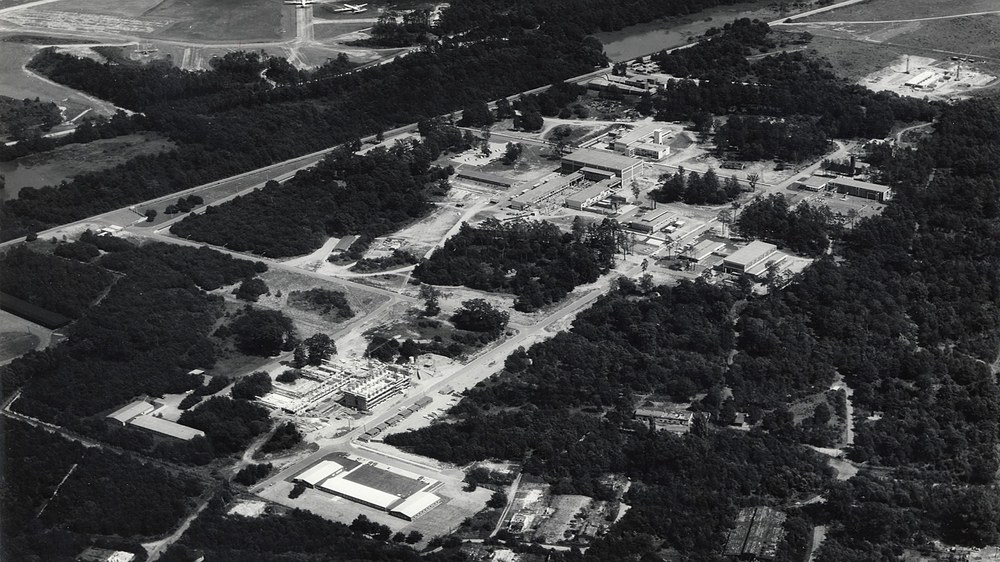Built to last – DLR's site in Cologne turns 60


There is one thing that has not changed at the DLR site in Cologne between the year of its establishment, 1959, and the present, 2019: construction. Back then, it was the start of something new, and today it represents DLR’s on-going growth. Here, at the headquarters of the Executive Board and the Head Office, the different fields of research – aeronautics, space, energy, transport, security and digitalisation – converge.
In 1959, Franz Josef Strauß, German Minister of Defence, laid the foundation stone for one of Europe’s most modern research and development facilities on the site of the former Wahn dynamite factory. In 1953, the ban that had been imposed on aviation research after World War II was lifted. Interest in science, economics and politics grew to establish a modern research institution for aviation in post-war Germany. The interim site of the German Institute of aviation (DVL), the forerunner of DLR, in Aachen was soon bursting at the seams. A temporary location at Essen-Mühlheim Airport proved unsuitable in the long term. A new solution was necessary: a site with a connection to an irport for research flight operations and enough space to accommodate new institutes and facilities. What was then a 35-hectare plot of land on the edge of he Wahner Heide, close to Cologne Airport, met all of the requirements.
The finest research on 55 hectares
In the years that followed, the DLR site in Cologne became well and truly established not only as a renowned location for German aeronautics research – with the institutes of Air Jet Propulsion, Applied Gas Dynamics, Space Research, Materials Research and Resistance – but also for space research, which was picking up speed. In Cologne, for example, German astronauts prepared for the Spacelab-1, D1, D2, MIR’92 and MIR’97 missions. Today, the researchers at what is now a 55-hectare site work on exploration missions such as ROSETTA, MASCOT and InSight, as well as scientific experiments on the International Space Station (ISS). Materials physicists conduct research into the effects of microgravity on materials or test how buildings might be constructed on the Moon using lunar dust. The ESA European Astronaut Centre is involved in the selection and training of astronauts. When German ESA astronaut Alexander Gerst returned to Earth from his first space flight in 2014, he flew directly to the DLR site in Cologne, instead of heading off to Houston or Moscow for follow-up examinations, like his predecessors. In Cologne, he was looked after at the :envihab aerospace medicine research facility. Today, most European astronauts come straight to the DLR site in Cologne upon their return to Earth. The aeronautics researchers in Cologne are also carrying on the tradition. One example is the HBK-5 high-pressure combustion chamber test facility of the Institute of Propulsion Technology. It was built in conjunction with industry partners Alstom and Rolls Royce and opened in 2014. Gas turbines for applications in energy technology and aviation have been tested there ever since. The site gained prominence at a European and international level due to its work with German-Dutch Wind Tunnels (DNW) and the European Transonic Wind Tunnel (ETW). Many institutes work closely with industry to ensure that scientific innovation is quickly transformed into marketable products. Even at the site, the short distances and synergies are conducive to working together: for instance, new turbine blade concepts are being developed at the Institute of Propulsion Technology and built as rototypes for test operation at Systemhaus Technik in Cologne.
Investing in the future
Together, the research institutes and facilities on the site work across all of the disciplines covered at DLR. Application-oriented institutes such as the institutes of Engineering Thermodynamics, Frontier Materials on Earth and in Space and Solar Research continue to evolve and therefore use the necessary research facilities together with their internal and external partners. As such, the Cologne location is likely to remain a building site for some time to come. Since 2013, the aforementioned institutes have been working together on technology for sustainable energy supply at the CeraStore centre of competence. One of DLR’s most recently established large-scale facilities is the Test Facility for Thermal Energy Storage in Molten Salt (TESIS), which went into operation in 2017, and is being used to further develop energy storage technologies on an industrial scale. A research building for the German Air Force Centre for Aerospace Medicine and a new building for the Executive Board are also being built. These will see the Cologne site continue to grow as DLR’s headquarters. And visitors to DLR are likely to walk past one building site or another for some years to come.
This article was published in DLRmagazine 161
Institutes and Facilities at the DLR site in Cologne
Partner Facilites at the site

